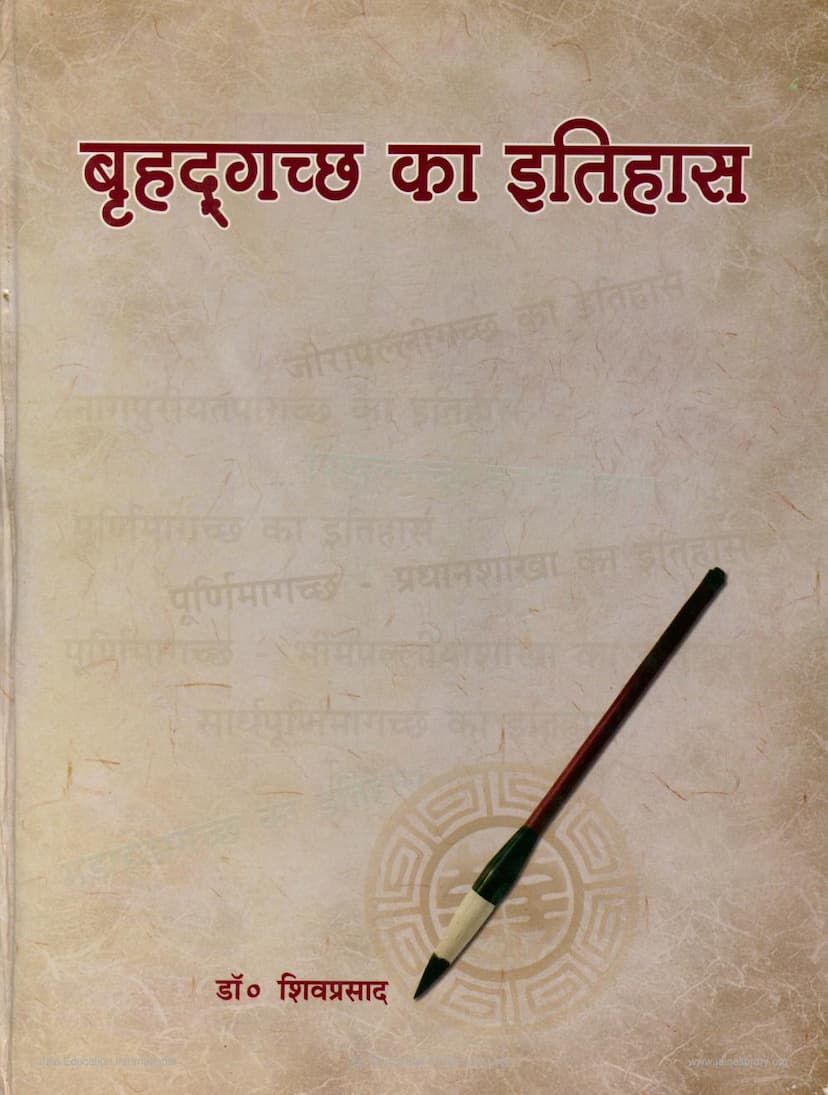Bruhad Gaccha Ka Itihas
Added to library: September 1, 2025

Summary
This document is an excerpt from the book "Bruhad Gaccha ka Itihas" (History of the Bruhad Gaccha) by Dr. Shivprasad, published by Omkarsuri Gyanmandir, Surat. It provides a detailed historical account of the Bruhad Gaccha, one of the ancient gacchas (sects or lineages) within the Shvetambara Jain tradition.
Here's a breakdown of the key information presented in the excerpt:
1. Origin and Name:
- The Bruhad Gaccha originated from the Chandra dynasty within the Shvetambara Jain tradition.
- Its name is derived from the banyan (Vata) tree under which Acharya Udyotansuri, a disciple of the Chandra lineage, conferred Acharyahood upon eight monks, including Shri Sarvadev, at the Dharman (Verman) settlement at the foot of Arbuda-giri.
- The lineage grew like the branches of the banyan tree, leading to its name "Bruhad Gaccha" (Great Gaccha).
2. Prominent Acharyas and Scholars: The text lists numerous influential and learned monks who belonged to this Gaccha, including:
- Sarvadevsurisuri
- Devsurisuri 'Viharuk'
- Nemichandrasuri 'Pratham'
- Udyotansuri 'Dwitiya'
- Amradevasuri 'Pratham'
- Devendragani (also known as Nemichandrasuri)
- Munichandrasuri
- Vadisurasuri
- Chandaprabhasuri (founder of the Purnimagaccha)
- Shantisuri (founder of the Pippalagaccha)
- Haribhadrasuri (famous author)
- Ramachandrasuri (blind scholar)
- Jaymangal suri
- Somachandrasuri
- Jnankalashmuni
- Hemchandrasuri
- Somaprabhasuri
- Vidyakar Gani (honored by Firoz Shah Tughlaq)
- Mahendrasuri (composer of Yantraraj, also honored by Firoz Shah Tughlaq)
- Malayachandra
- Vachak Vinayaratna
- Bhavadevasuri
- Muni Maldev
3. Historical Significance and Decline:
- The Gaccha played a significant role in establishing numerous Jin-pratimās (images of Jinas) between the 13th and 16th centuries VS.
- The rise of the Sthanakavasi tradition led to a decline in the influence of most Gacchas, including the Bruhad Gaccha, except for the Kharatara, Tapu, and Anchala Gacchas.
- Although the Bruhad Gaccha itself is no longer extant in its original form, the Nagpuriya Tapagaccha, which originated from it, continues to exist today as the Parshwachandra Gaccha.
4. Research and Sources: The author was inspired to write this history after studying the histories of other prominent Gacchas. He received guidance from scholars like Prof. M.A. Dhanki, Mahopadhyaya Vinaysagar, and Prof. Sagarmalji Jain. The book's primary sources include:
- Literary Evidence:
- Prashastis (inscriptions within texts, often at the end of manuscripts), which provide details about authors, their gurus, Gacchas, and historical context.
- Pattavalis and Gurvavalis (genealogies of gurus and lineages).
- Epigraphic Evidence:
- Pratimālēkhs (inscriptions on images)
- Shilālēkhs (stone inscriptions), often found in temples and at pilgrimage sites.
5. Structure of the Book: The book is divided into seven chapters:
- Chapter 1: Discusses the source materials for the history of the Bruhad Gaccha.
- Chapter 2: Provides a brief history of the initial period of the Bruhad Gaccha.
- Chapter 3: Mentions the prominent Acharyas of the Bruhad Gaccha and the various Gacchas that originated from it.
- Chapter 4: Focuses on Acharya Vadisurasuri and his extensive lineage.
- Chapter 5: Presents a table of epigraphic evidence related to the Bruhad Gaccha and the guru lineages derived from them.
- Chapter 6: Details the literary contributions of the monks of the Bruhad Gaccha in a table format.
- Chapter 7: Offers a historical study of the various Gacchas that originated from the Bruhad Gaccha, including Jirapalligaccha, Nagpuriya Tapagaccha, Pippalagaccha, Purnimagaccha, and Madahadagaccha. The book also includes two appendices.
6. Acknowledgements and Publication: The research was supported by the Indian Council of Historical Research. The author expresses gratitude to various libraries and individuals, including Acharya Munichandrasuri, for their assistance. The publication was undertaken by Omkarsuri Aradhana Bhavan, Surat, and printed by Kirit Graphics, Ahmedabad.
7. Scope and Content: The excerpt highlights the meticulous research undertaken by the author, Dr. Shivprasad, in compiling information from various ancient texts, inscriptions, and manuscripts. It emphasizes the importance of these sources for reconstructing the history of Jain gacchas and their scholarly contributions. The book aims to provide a comprehensive understanding of the Bruhad Gaccha's lineage, its prominent figures, its influence, and its eventual transformation into other lineages.